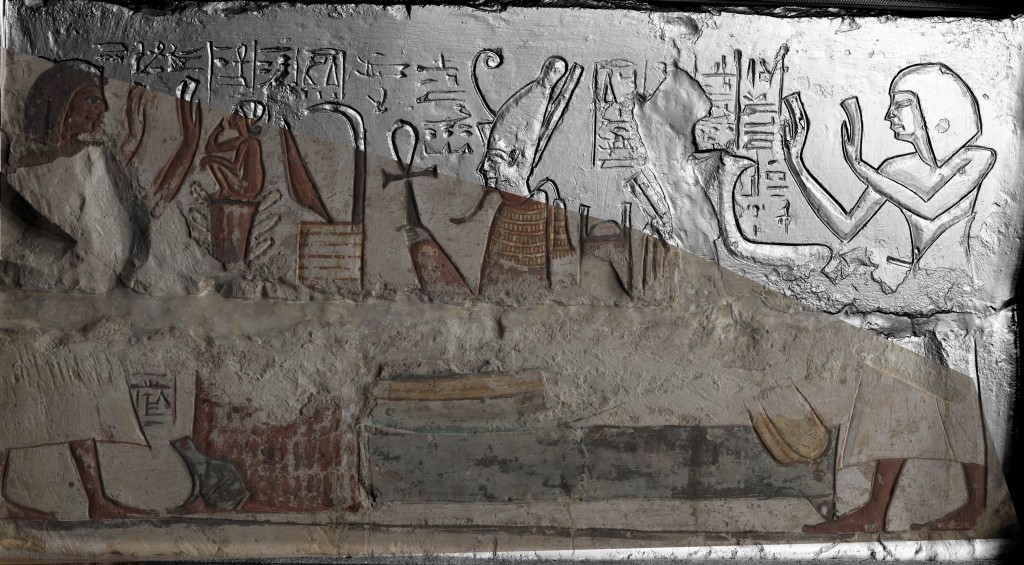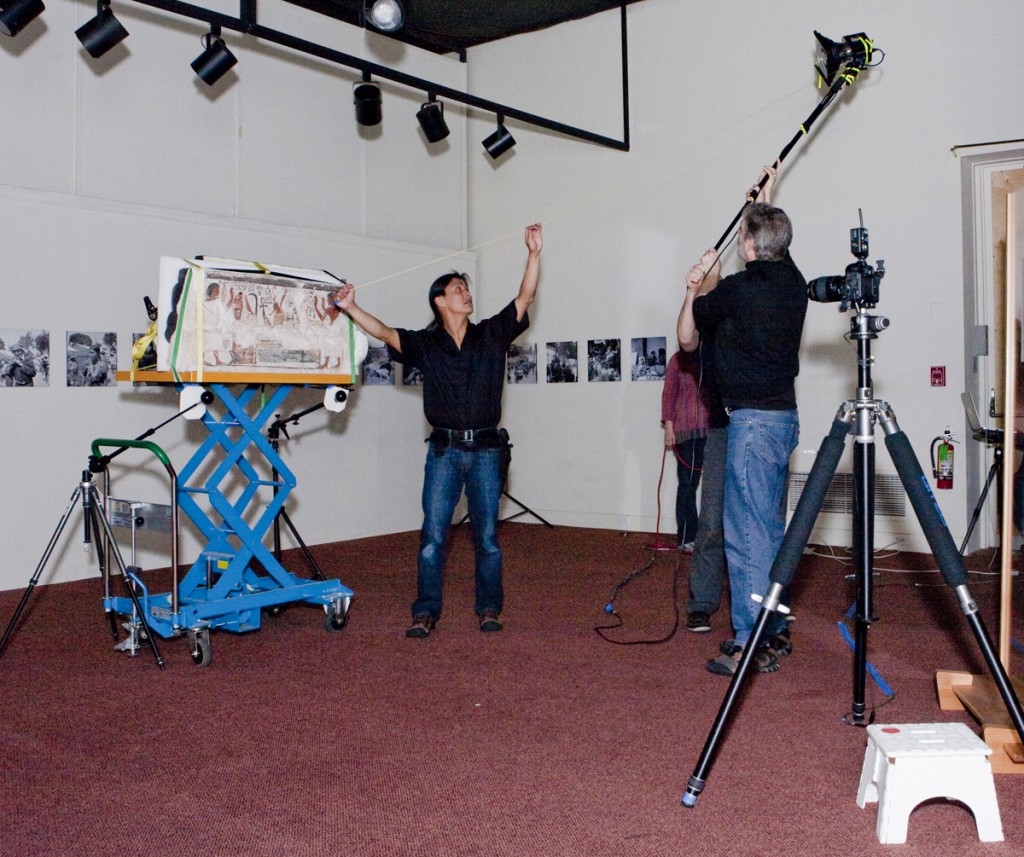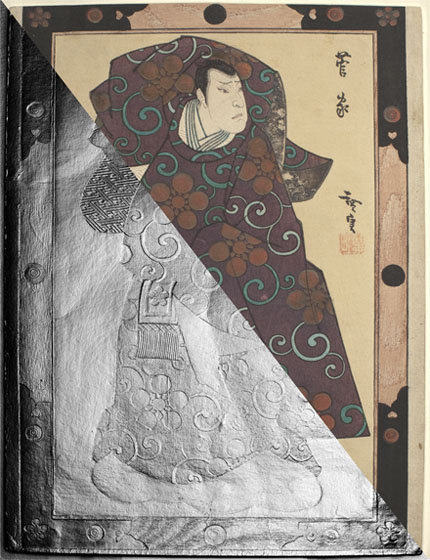by Patrick Hunt

While photography of archaeological artifacts for recording stretches back over a century plus, the needs to visually preserve a record of materials has only multiplied exponentially since the mid-19th century. In fact, archaeology was one of the first disciplines to employ the nascent medium of photography for recording. Now digital technology in photography has unlocked whole new imaging possibilities for archaeological recording, virtual archaeology and subtle metadata.
Before archaeological visionaries Mark Mudge and Carla Schroer founded Cultural Heritage Imaging (CHI) in 2002, their dreams of applying digital technology to archaeological research stretch back a long way. Mark and Carla were among the first pioneers to see and unlock the future in new possibilities of light in digital photography. Before founding CHI, Mark started out as a sculptor and digital photographer and then was a 3D capture and computer modeling instructor at the Academy of Art and Expressions College. He was among the first to introduce laser scanning and 3D computer modeling to sculpture. Carla spent twenty years in commercial software development and testing and was part of the original team at Sun Microsystems that brought Java to market in 1995. She continued to work on Java software for thirteen years.
One of their first team projects was in the Alps of Switzerland and Italy, participating with the Stanford Alpine Archaeology Project in 2000-2005 at the Grand-St-Bernard Pass, photographing project excavation seasons and artifacts. In 2004, Mark produced the first archaeological Reflectance Transformation Imaging (RTI) data ever acquired on site during an active excavation at the Stanford Alpine Archaeology Project field site. Stanford University was thus the first academic institution to work with CHI, followed by others in Europe, and this growing group now includes Princeton University, Yale University, and the University of California.
In Switzerland CHI soon began sharing state-of-the-art imaging expertise with Canon Jean-Pierre Voutaz, the Archivist of the Grand-St-Bernard Monastery-Hospice, whose Medieval and Renaissance library and monastic natural history and archaeological collections provided a ready application as well related collections in the Museum of Grand-St-Bernard Monastery-Hospice. Soon Lausanne’s Cantonal Monetary Museum was knocking at their door. Since that initial phase, CHI has also subsequently worked in the Crimean Peninsula at the site of Chersonesos and rock art sites in UNESCO-targeted heritage contexts in Portugal’s Archaeological Park Vale do Côa, among others. In 2007, Mark and Carla also captured the first RTI documentation of gilded Byzantine mosaics from the 6th century apse of ‘The Church of Our Lady Angeloktisti” at Kiti, Larnaka, Cyprus.
Development of their open source imaging techniques burgeoned as each recipient of their expertise shared with others, and within a few years they were working with international and national museums such as the Smithsonian in Washington DC and most recently the The Fine Arts Museums of San Francisco, the Museum of Modern Art and the Metropolitan Museum of Art in New York.
From 2005-2010, CHI has presented and lectured at symposia and congresses at the Louvre in Paris, at both Seville and Granada, Spain, several in Athens, Greece, Malta, Cyprus, as well as congresses in Budapest, Berlin, Pisa and at the 6th World Archaeological Congress in Dublin, Ireland, among others. Many of these events have been sponsored by international working groups in Quantitative Methods in Archaeology and Computer Applications in Archaeology (CAA).

CHI’s founders are recipients of multiple awards including from the Samuel H. Kress Foundation and two recent grants, the first from the National Science Foundation shared with Princeton University and the second from the Institute for Museum and Library Services, Spain’s Tartessos Prize, and joint projects funded by the Andrew Mellon Foundation, among others. In 2010 in San Francisco, the Archaeological Institute of America recognized their contributions to imaging preservation playing a vital role in archaeology, visiting their San Francisco facilities. CHI’s pioneering work was also praised in a keynote lecture at the Fairmont Hotel at the AIA San Francisco Soirée in October, 2010.
CHI takes multiple important digital imaging technology training programs to museums and universities in order to train museum imaging professionals. These technologies include Polynomial Texture Mapping (PTM) and Reflectance Transformation Imaging (RTI). Another of their featured technology projects is the Collaborative Algorithmic Rendering Engine (CARE), their current project with Princeton University, being developed by computer scientists and mathematicians to render objects quantitatively through algorithms in multiple viewing frames of reference from RTI data.
According to the available literature, Reflectance Transformation Imaging (RTI) is a useful conservation tool for powerful documentation, and conservation is a growing vital part of archaeology as responsible archaeology invests more and more energy and resources in preservation rather than excavation as was mostly the case for decades. Too many museums around the world are still filled with over a century’s worth of excavated objects that have yet to be optimally conserved. Not only the objects themselves but preserving images of objects is also critical, especially when excavated objects continue to weather in oxidizing environments, even incrementally over time. Additionally, RTI makes better examination of surfaces possible, enhancing the interpretation of cultural heritage materials, especially contoured relief artifacts. Normal photography does not always necessarily enhance three-dimensionality in the way that specular light moving over a surface does. This RTI specularity is a new feature of digital photography in changing light circumstances that computers have revolutionized, especially since RTI is an image-based representation of a surface appearance using different directions of light, bringing out surface details because computer algorithms can render an object’s surface down to the individual pixel level. Multiple source light can be manipulated in so many more ways than single source light. The data acquired digitally contains information about exact three-dimensional shape and minute surface properties of the object photographed, as very detailed relief is another enhanced feature of specular and multiple source light. This actual relief is greatly improved by RTI, as can be seen from both the Sennenjem Lintel (above) and the Hirosada woodcut (below). This abstract photographic information collected by RTI is used to construct dynamic, interactive digital representations that allow mathematical enhancement and rendering in a variety of ways to reveal features that are otherwise difficult or impossible to see through direct examination in single source light. I’ve seen many CHI object photograph sessions in the Alps inside the monastery of the Grand-St-Bernard, where they have set up light arrays using a geodesic dome made from pvc tubes with equidistant lights at each junction.
One of the best applications I’ve seen from CHI is photographing numismatic material. Coins, although small, can contain many artistic and minting details that mobile specular light captures. In antiquity Greek coins were even an art form on the micro scale where sculptors made miniature masterpieces not always easily seen except in close examination, so RTI is a great tool for tracing changes in individual coin mintings and even highlighting artistic idiosyncrasies. RTI also produces significant advantages to conservation, including information that is scientifically reliable, acquisition of data not requiring physical contact, clear representation of 3D characteristics of shape via RTI enhancement functions, reduced or zero data loss due to shadows and specular highlights – since these can be manipulated or changed – as well as high resolution sample densities up to 20,500 per square millimeter. Since so many of us involved in archaeology and art frequently transmit high density, high resolution images electronically and near instantaneously over the internet, the ability to send RTI photographs is becoming increasingly easier as well, with RTI creating easily achievable image processing pathways, and facile communication online. RTI also provides museum curators and conservators with new means to share data with other professionals, scholars and the public in a highly interactive way that greatly expands the viewing experience. This is not just inside a museum. CHI has also shown in global contexts using mobile technology in the field: rock art is one more archaeological medium aided by RTI because its variable light can easily distinguish between tool marks and methods from incising, pecking, etc. These advantages RTI brings in photographic recording will be further elaborated in continuing technology advances.

Polynomial Texture Mapping (PTM) was the original form of Reflectance Transformation Imaging (RTI), developed by Tom Malzbender, Dan Gelb and others at Hewlett-Packard (HP) Labs. It was applied to archaeological materials by Mark Mudge, Carla Schroer and other CHI staff. From HP Labs is this description of PTM technology:
“Polynomial Texture Maps (PTMs) are a simple representation for images of functions instead of just images of color values. In an conventional image, each pixel contains static red, green, blue values. In a PTM, each pixel contains a simple function that specifies the red, green, blue, values of that pixel as a function of two independent mathematical parameters, lu and lv.
Typically, PTMs are used for displaying the appearance of an object under varying lighting direction, and lu ,lv specify the direction of a point light source. However, other applications are possible, such as controlling focus of a scene. PTMs can be used as light-dependent texture maps for 3D rendering, but typically are just viewed as ‘adjustable images’.
PTMs are typically produced with a digital camera by photographing an object multiple times with lighting direction varying between images. Even a low-end digital camera provides enough resolution to produce good PTMs, and almost any light source can be used such as a light bulb, LED or flash.”
Naturally, as nanotech drives the computer industry with better and better megapixel volume leading to higher resolution, combined with more memory capabilities, the world of imaging technology is becoming increasingly sophisticated and quantifiable ever since cameras have been loaded with computer chips enabling digital recording. Who even remembers photo film developing?
Mark Mudge and Carla Schroer and their team at CHI are to be commended for seeing the archaeological imaging future so clearly, and what they share now to an eager world of archaeology professionals will pave the way for new recording and quantitative preservation in technologies not yet even imagined.